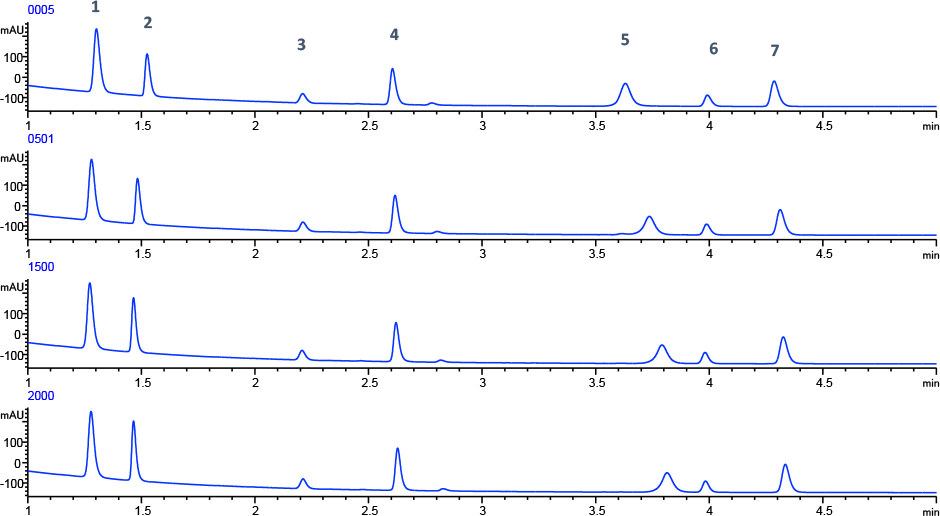Access Agilent eNewsletter January 2016

Ask the Expert: Can I improve the chromatography of basic compounds on my older HPLC systems?
Stephen Luke, Agilent Product Manager
To address this question, our experts discuss the wide range of Agilent Poroshell 120 4 µm columns, their applications, and how they help chromatographers who want to work with longer column formats, such as 4.6 x 250 mm, or who want to restrict system pressure to below 200 bar (3,000 psi).
Q: Can I get the benefits of columns packed with superficially porous particles on my older HPLC systems?
Answer: Columns packed with Agilent Poroshell 120 superficially porous silica particles provide numerous benefits to analysts compared to those packed with totally porous particles. These benefits include faster run times and higher resolution enabled by high efficiencies at reasonable pressures.
Q: What are the advantages and disadvantages of high pH mobile phases?
Answer: Basic compounds, such as many drug substances, can be challenging to analyze by reversed-phase HPLC because of their tendency to ionize in the mobile phase. This ionization can result in poor retention, peak shape, resolution, and loading capacity. Increasing the pH of the mobile phase is a good way to suppress ionization of basic compounds. However, this approach can cause problems with column lifetime due to the dissolution of the silica column packing in mobile phase with pH above 7 to 8.
Q: Is there an analysis solution available that features high stability and low degradation?
Answer: Yes. Agilent developed a proprietary organic modification of the superficially porous silica particle surface and launched Agilent Poroshell HPH-C18 and HPH-C8 columns, which feature stability from pH 3.0 to 11.0. Previously available with a 2.7 µm particle diameter these columns are now also available with 4 µm particles.

Figure 1. The Agilent Poroshell HPH-C18. 2.1 x 50 mm, 4 µm delivers excellent chromatography and stability at pH 10 for basic compounds.
Q: What results can I expect?
Answer: In Figure 1, our results show excellent chromatography of basic compounds using the Poroshell HPH-C18. 2.1 x 50 mm, 4 µm column in a mobile phase at pH 10. Furthermore, there is no degradation in chromatography over 2,000 injections.
Agilent Poroshell HPH-C18 and Poroshell HPH-C8 4 µm columns deliver the combined benefits of faster run times and higher resolution, plus the excellent chromatography of basic compounds, available for all HPLC users.
Agilent Poroshell 120 solutions deliver quicker run times and higher resolution
Poroshell 120 columns provide rugged, high-resolution separations within the pressure range of any mainstream LC system. Available in 2.7 µm and 4 µm particle diameters and with a family of twelve phase chemistries aligned with ZORBAX chemistries, method development and transfer is flexible and easy.
What’s more, the Agilent family of Poroshell LC columns are all designed and manufactured end to end by Agilent, including multiple QC tests and chromatographic tests to tight QC specifications. This ensures that chromatographers will experience rugged, reproducible performance with long column lifetime. Take a look at this video now to see how Agilent builds consistency into its Poroshell and ZORBAX offerings. Then visit our web site to learn more about Agilent’s Poroshell solutions today.
Stay informed about the applications that are important to you
Subscribe to Access Agilent
Our free customized
monthly eNewsletter
Article Directory – January 2016
All articles in this issue
-
 What is in your beer? Find out using a Agilent J&W DB-624 Ultra Inert (UI) column with GC/MS static headspace solution
What is in your beer? Find out using a Agilent J&W DB-624 Ultra Inert (UI) column with GC/MS static headspace solution -
 Moving biologics to market with automated biopharma workflow solution
Moving biologics to market with automated biopharma workflow solution -
 Nobel Prize-winning lab uses Agilent equipment to accelerate natural product discoveries
Nobel Prize-winning lab uses Agilent equipment to accelerate natural product discoveries -
 Tip: How to detect leachables from drug container closures in pharmaceutical products
Tip: How to detect leachables from drug container closures in pharmaceutical products -
 Fast, accurate absolute-quantification of proteins and antibodies with Agilent 8800 ICP-QQQ
Fast, accurate absolute-quantification of proteins and antibodies with Agilent 8800 ICP-QQQ -
 Chevron and Agilent collaborate on new multi-element crude oil analysis technology that delivers advantages in speed, cost, and safety
Chevron and Agilent collaborate on new multi-element crude oil analysis technology that delivers advantages in speed, cost, and safety -
 Ask the Expert: Can I improve the chromatography of basic compounds on my older HPLC systems?
Ask the Expert: Can I improve the chromatography of basic compounds on my older HPLC systems? -
 More pesticides identified using Agilent Pesticide DRS Screening GC/MSD Analyzer with new high efficiency source
More pesticides identified using Agilent Pesticide DRS Screening GC/MSD Analyzer with new high efficiency source -
 Improved peak shapes for active semivolatiles with inert Agilent J&W DB-UI 8270D columns
Improved peak shapes for active semivolatiles with inert Agilent J&W DB-UI 8270D columns
Figure 1

Peak ID
- 2-Hydroxy-5 methyl-benzaldehyde
- 4-Chloro-cinnamic acid
- Acetophenone
- Quinine sulfate
- Nortriptyline
- Hexanophenone
- Amitriptyline
| Conditions | |||||||||||
|---|---|---|---|---|---|---|---|---|---|---|---|
| Column | Poroshell HPH-C18, 2.1 x 50 mm, 4 µm | ||||||||||
| Mobile phase | A, Acetonitrile; B, ammonium bicarbonate, 10 mM, pH 10 | ||||||||||
| Gradient |
|
||||||||||
| Temp | 25 °C | ||||||||||
| Flow rate | 0.4 mL/min | ||||||||||
| Detector | UV, 220 nm, 4 nm, ref off | ||||||||||
| System | Agilent 1290 Infinity LC with PEEK rotor seals | ||||||||||
The Agilent Poroshell HPH-C18. 2.1 x 50 mm, 4 µm delivers excellent chromatography and stability at pH 10 for basic compounds.